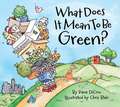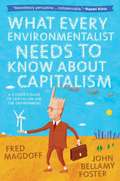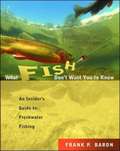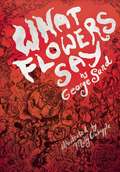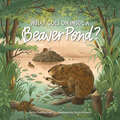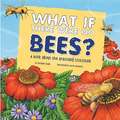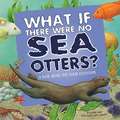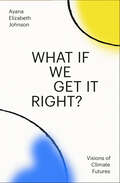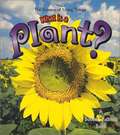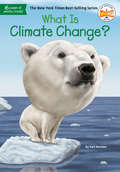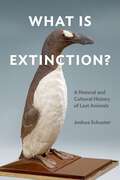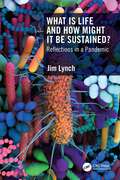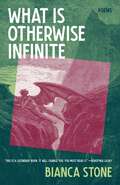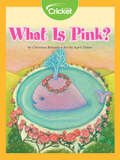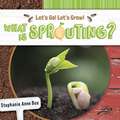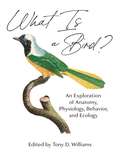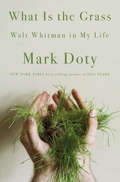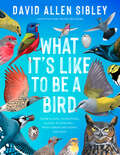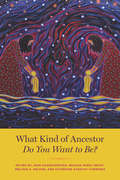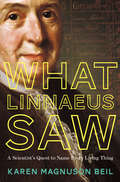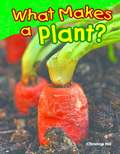- Table View
- List View
What Does It Mean To Be Green?
by Chris Blair Rana DiOrioDrawing on two sides of your paper instead of just one. Walking to the park instead of getting a ride. Turning off the water while you brush your teeth. A young boy and girl explore all the different ways they can be Green over the course of a day. They discover lots of amazing facts (like our food travels an average of 1,500 miles to be on our plate!) and realize there's so much they-and we-can do to save our world!
What Every Environmentalist Needs to Know About Capitalism
by Fred Magdoff John Bellamy FosterThere is a growing consensus that the planet is heading toward environmental catastrophe: climate change, ocean acidification, ozone depletion, global freshwater use, loss of biodiversity, and chemical pollution all threaten our future unless we act. What is less clear is how humanity should respond. The contemporary environmental movement is the site of many competing plans and prescriptions, and composed of a diverse set of actors, from militant activists to corporate chief executives. This short, readable book is a sharply argued manifesto for those environmentalists who reject schemes of "green capitalism" or piecemeal reform. Environmental and economic scholars Magdoff and Foster contend that the struggle to reverse ecological degradation requires a firm grasp of economic reality. Going further, they argue that efforts to reform capitalism along environmental lines or rely solely on new technology to avert catastrophe misses the point. The main cause of the looming environmental disaster is the driving logic of the system itself, and those in power--no matter how "green"--are incapable of making the changes that are necessary. What Every Environmentalist Needs To Know about Capitalism tackles the two largest issues of our time, the ecological crisis and the faltering capitalist economy, in a way that is thorough, accessible, and sure to provoke debate in the environmental movement.
What Fish Don't Want You To Know: An Insider's Guide to Freshwater Fishing
by Frank P. BaronExpert, field-tested advice for anglers at every level. This comprehensive, entertaining, and foolproof guide covers everything novice and avid anglers need to know to catch freshwater fish--from bass and trout to salmon and walleye--and reveals the two basic ways to catch ALL fish. With numerous photographs and illustrations, easy-to-follow instructions, and a liberal dose of good humor, the author shares his 40 years of angling expertise, including how to read the waters and the weather, select the right baits and lures for particular fish and situations, know which gear is essential and which is merely desirable, get maximum results on a minimum budget, practice proper etiquette and ethics, and to turn a tough day into a great one with dozens of tricks and tips. Laced with amusing anecdotes, this book will unlock the secrets of fishing and teach anglers how to catch more fish.
What Flowers Say
by George Sand Molly Crabapple Holly Erskine HirkoRoses plead to go out to dance; an old oak tree offers advice; paintings of gods and goddesses come alive. In What Flowers Say, renowned writer George Sand dares children to fantasize, to believe in an alternate world. This magical collection, originally penned for her grandchildren, calls into question what is real, a life lesson from someone who refused to accept the gender roles available to women in the nineteenth century. Sand shares her love and immense knowledge of science and mythology, engages issues of class and character, and captures the wonder and determination of a curious child, offering all of us a true sense of infinite possibilities--well beyond the world we live in.George Sand (1804-76) is considered the first professional woman writer of fiction. She wrote many novels, including Indiana and Léila, plays, newspaper articles, and a memoir, Story of My Life. The movie Impromptu is based on her life.Molly Crabapple is a painter, illustrator, and writer based in New York. She has written many books, including Discordia and Week in Hell, and produced work on subjects including the Spanish general strike, her former career as a pinup model, her arrest during Occupy Wall Street, and her visit to Guantanamo Bay. Her illustrated memoir, Drawing Blood, is forthcoming in 2015.
What Goes on inside a Beaver Pond?
by Becky Cushing GopDive into the fascinating world of beavers—the swimmers, builders, and engineers of the animal kingdom! What Goes on inside a Beaver Pond? takes kids ages 8 to 10 on a journey through a year in the life of a young beaver (called a "kit"). This is an exciting year as the young beaver leaves her family lodge and moves throughout the Yokun Brook waterways, seeking a new home for herself. Throughout the seasons, vibrant illustrations and descriptions reveal the hidden inner-workings of a beaver lodge, how beavers fell trees with their teeth and create a wetland habitat, how they collect food and ward off predators, and what daily life is like within a beaver colony. Educational side panels enhance the story with details about beaver behavior and anatomy, as well as information about what other animal inhabitants of the pond are up to throughout the year. Author Becky Cushing Gop is an environmental educator and director of Mass Audubon&’s Pleasant Valley Wildlife Sanctuary where the story takes place. Nature illustrator Carrie Shryock&’s lively and charming graphics bring the young beaver&’s story to life for nature-curious kids.
What Happens to Our Trash? (Let's-Read-and-Find-Out Science 2)
by D. J. WardRead and find out about how we can reduce, reuse, and recycle in this colorfully illustrated nonfiction picture book."Perfect for classes just beginning to study environmental concerns," wrote School Library Journal. "Engaging prose and upbeat, gently humorous illustrations introduce the importance of proper trash disposal and recycling."This is a clear and appealing science book for early elementary age kids, both at home and in the classroom. In clear language and art, including diagrams, the book takes readers through such details as how much trash each person creates every day (on average), where the trash goes, and ways kids can make a difference. It concludes with instructions on how to create a compost pileWhat Happens to Our Trash is a Level 2 Let's-Read-and-Find-Out, which means the book explores more challenging concepts for children in the primary grades. The 100+ titles in this leading nonfiction series are:hands-on and visualacclaimed and trustedgreat for classroomsTop 10 reasons to love LRFOs:Entertain and educate at the same timeHave appealing, child-centered topicsDevelopmentally appropriate for emerging readersFocused; answering questions instead of using survey approachEmploy engaging picture book quality illustrationsUse simple charts and graphics to improve visual literacy skillsFeature hands-on activities to engage young scientistsMeet national science education standardsWritten/illustrated by award-winning authors/illustrators & vetted by an expert in the fieldOver 130 titles in print, meeting a wide range of kids' scientific interestsBooks in this series support the Common Core Learning Standards, Next Generation Science Standards, and the Science, Technology, Engineering, and Math (STEM) standards. Let's-Read-and-Find-Out is the winner of the American Association for the Advancement of Science/Subaru Science Books & Films Prize for Outstanding Science Series.
What If There Were No Bees?: A Book About The Grassland Ecosystem
by Carol Schwartz Suzanne SladeGrassland ecosystems can be found on nearly every continent. Countless animals and plants live in them. So what difference could the loss of one animal species make? Follow the chain reaction, and discover how important honey bees are.
What If There Were No Sea Otters?: A Book About The Ocean Ecosystem
by Carol Schwartz Suzanne SladeThe ocean ecosystem is huge, covering most of our planet. Countless animals and plants live there. So what difference could the loss of one animal species make? Follow the chain reaction, and discover how important sea otters are.
What If We Get It Right?: Visions of Climate Futures
by Ayana Elizabeth Johnson&“With a thoughtfully curated series of essays, poetry, and conversations, the brilliant scientist and climate expert Ayana Elizabeth Johnson has assembled a group of dynamic people who are willing to imagine what seems impossible, and articulate those visions with enthusiastic clarity.&”—Roxane GayOur climate future is not yet written. What if we act as if we love the future?Sometimes the bravest thing we can do while facing an existential crisis is imagine life on the other side. This provocative and joyous book maps an inspiring landscape of possible climate futures.Through clear-eyed essays and vibrant conversations, infused with data, poetry, and art, Ayana Elizabeth Johnson guides us through solutions and possibilities at the nexus of science, policy, culture, and justice. Visionary farmers and financiers, architects and advocates, help us conjure a flourishing future, one worth the effort it will take—from every one of us, with whatever we have to offer—to create.If you haven&’t yet been able to picture a transformed and replenished world—or to see yourself, your loved ones, and your community in it—this book is for you. If you haven&’t yet found your role in shaping this new world or you&’re not sure how we can actually get there, this book is for you.With grace, humor, and humanity, Johnson invites readers to ask and answer this ultimate question together: What if we get it right?On possibility and transformation with:Paola Antonelli • Xiye Bastida • Jade Begay • Wendell Berry • Régine Clément • Steve Connell • Erica Deeman • Abigail Dillen • Brian Donahue • Jean Flemma • Kelly Sims Gallagher • Rhiana Gunn-Wright • Olalekan Jeyifous • Corley Kenna • Bryan C. Lee Jr. • Franklin Leonard • Adam McKay • Bill McKibben • Kate Marvel • Samantha Montano • Kate Orff • Leah Penniman • Marge Piercy • Colette Pichon Battle • Kendra Pierre-Louis • Judith D. Schwartz • Jigar Shah • Ayisha Siddiqa • Bren Smith • Oana Stănescu • Mustafa Suleyman • Jacqueline Woodson
What Is A Plant? (The Science Of Living Things)
by Bobbie KalmanPlants provide people and animals with food, shelter, and even oxygen. Plants help us live and grow, but how does a plant grow? Where do plants grow? What is a Plant? introduces young readers to a variety of plant types, including ferns, carnivorous plants, mosses, and trees. This fact-filled book explains:-photosynthesis-different methods of reproduction-how seeds germinate and grow-which types of plants grow in different climates-how plants defend themselves
What Is Climate Change? (What Was?)
by Gail Herman John Hinderliter Who HqLearn more about what climate change means and how it's affecting our planet.The earth is definitely getting warmer. There's no argument about that, but who or what is the cause? And why has climate change become a political issue? Are humans at fault? Is this just a natural development? While the vast majority of scientists who study the environment agree that humans play a large part in climate change, there is a counterargument. Author Gail Herman presents both sides of the debate in this fact-based, fair-minded, and well-researched book that looks at the subject from many perspectives, including scientific, social, and political.
What Is Earth Day?: A Good Answer to a Good Question
by Who HqDirect from Who HQ, the team that brings you the New York Times Best-Selling Who Was? biography series, comes Who HQ Presents. These short illustrated e-Books provide quick, simple answers to the important questions being asked today about politics, social issues, the environment, and more!What is Earth Day? Wonder no more: Who HQ Presents answers about how this environmental celebration came about, and how you can join in.
What Is Extinction?: A Natural and Cultural History of Last Animals
by Joshua SchusterWINNER, 25th ANNUAL SUSANNE M. GLASSCOCK BOOK PRIZELife on Earth is facing a mass extinction event of our own making. Human activity is changing the biology and the meaning of extinction. What Is Extinction? examines several key moments that have come to define the terms of extinction over the past two centuries, exploring instances of animal and human finitude and the cultural forms used to document and interpret these events.Offering a critical theory for the critically endangered, Joshua Schuster proposes that different discourses of limits and lastness appear in specific extinction events over time as a response to changing attitudes toward species frailty. Understanding these extinction events also involves examining what happens when the conceptual and cultural forms used to account for species finitude are pressed to their limits as well. Schuster provides close readings of several case studies of extinction that bring together environmental humanities and multispecies methods with media-specific analyses at the terminus of life.What Is Extinction? delves into the development of last animal photography, the anthropological and psychoanalytic fascination with human origins and ends, the invention of new literary genres of last fictions, the rise of new extreme biopolitics in the Third Reich that attempted to change the meaning of extinction, and the current pursuit of de-extinction technologies. Schuster offers timely interpretations of how definitions and visions of extinction have changed in the past and continue to change in the present.
What Is Life and How Might It Be Sustained?: Reflections in a Pandemic
by Jim LynchHow did the universe and life begin and what are the threats to people and the environment in a pandemic? This book is for anybody with interest in protecting life on the planet. Studies on the origin of life and scientific contributions to safeguarding the planet are examined in light of current thinking on climate change. A major focus is the spread of microbes, put in the context of environmental assessment and management, including descriptions of microbiomes and a consideration of the risks of genetic modifications. Professor Lynch shows how failure to control disease can lead to the collapse of any biotic population. To avoid this, the ethics of management of disease by biological control and by vaccination are discussed, at the practical level and in a moral theological context.
What Is Otherwise Infinite: Poems
by Bianca StoneFinalist for the New England Book Award in Poetry and the Vermont Book Award As heard on NPR Morning Edition A New York Public Library Best Book of 2022 A searching, startling new collection of poems from the author of The Möbius Strip Club of Grief and Someone Else’s Wedding Vows Written in four sections with incisive and vivid lyrical language, Bianca Stone’s What Is Otherwise Infinite considers how we find our place in the world through themes of philosophy, religion, environment, myth, and psychology. “I deal only in the hardest pain-revivers, symbols and tongues,” writes Stone. “I want to tell you only / in the intimacy of our discomfort.” Populated by Archangels, limping in paradise; by allergies of the soul; the intimacy and danger of motherhood; psychic wounds; and dirty, dirty chocolate layer cake, What Is Otherwise Infinite deftly examines our inherent and inherited ideas of how to live, and the experience of the Self—which on one hand is so intensely personal, and on the other, universal.
What Is Pink?
by Christina RossettiEverywhere you look, there are beautiful colors throughout nature!
What Is Sprouting? (Let’s Go! Let’s Grow!)
by Stephanie Anne BoxIntroduce your child to science, biology, and plant life with the children’s book What Is Sprouting?Did you know that plants are also living things? Learn about the life cycle of a plant from its beginnings as a seed to how they are helpful to humans.Storybook Features:This children’s book features new vocabulary, a photo glossary, an index, and reading activity.24 pages of vivid photographsLexile 290LAbout RourkeWe proudly publish respectful and relevant non-fiction and fiction titles that represent our diverse readers, and are designed to support reading on a level that has no limits!
What Is a Bird?: An Exploration of Anatomy, Physiology, Behavior, and Ecology
by Tony D. Williams Scott McWilliams Julia A. Clarke Elizabeth MacDougall-Shackleton Scott MacDougall-Shackleton Frances Bonier Chad EliasonA large-format, beautifully illustrated look at the natural history of birdsThere are some 10,000 bird species in existence today, occupying every continent and virtually every habitat on Earth. The variety of bird species is truly astounding, from the tiny bee hummingbird to the large flightless ostrich, making birds one of the most diverse and successful animal groups on the planet. Taking you inside the extraordinary world of birds, What Is a Bird? explores all aspects of these remarkable creatures, providing an up-close look at their morphology, unique internal anatomy and physiology, fascinating and varied behavior, and ecology. It features hundreds of color illustrations and draws on a broad range of examples, from the familiar backyard sparrow to the most exotic birds of paradise. A must-have book for birders and armchair naturalists, What Is a Bird? is a celebration of the rich complexity of bird life.An absorbing and beautifully presented exploration of the natural history of birdsIntegrates physiological adaptations with ecology and behaviorFeatures a wealth of color photographs and explanatory figuresUses scanning electron microscope imagery to provide a rare close-up view of structures not normally visibleProvides insights into our complex relationship with birds, from our enduring fascination with them to the threats they face and the challenges of conservation
What Is the Grass: Walt Whitman In My Life
by Mark DotyNamed a Most Anticipated Book of 2020 by Buzzfeed, Library Journal, The Millions, and The Rumpus Effortlessly blending biography, criticism, and memoir, National Book Award–winning poet and best-selling memoirist Mark Doty explores his personal quest for Walt Whitman. Mark Doty has always felt haunted by Walt Whitman’s bold, perennially new American voice, and by his equally radical claims about body and soul and what it means to be a self. In What Is the Grass, Doty—a poet, a New Yorker, and an American—keeps company with Whitman and his Leaves of Grass, tracing the resonances between his own experience and the legendary poet’s life and work. What is it then between us? Whitman asks. In search of an answer, Doty explores spaces—both external and internal—where he finds the poet’s ghost. He meditates on desire, love, and the mysterious wellsprings of the poet’s enduring work: a radical experience of transformation and enlightenment, queer sexuality, and an obsession with death, as well as unabashed love for a great city and for the fresh, rowdy character of American speech. In riveting close readings threaded with personal memoir and illuminated by awe, Doty reveals the power of Whitman’s persistent presence in his life and in the American imagination at large. How does a voice survive death? What Is the Grass is a conversation across time and space, a study of the astonishment one poet finds in the accomplishment of another, and an attempt to grasp Whitman’s deeply hopeful vision of human possibility.
What It's Like to Be a Bird (Adapted for Young Readers): From Flying to Nesting, Eating to Singing--What Birds Are Doing and Why
by David Allen SibleyIn this edition for young readers adapted from the bestselling work written and illustrated by David Allen Sibley, readers will find a unique treasure trove of fascinating facts about birds, paired with more than 300 full-color illustrations—some life-size! The extraordinary world of birds is brought to life on the page. Did you know that many species of birds have sensory abilities that surpass those of humans? Or that some birds spend the entire winter in the air, and even sleep while flying? Have you ever wondered why birds have feathers? Or why they are a particular color? Have you noticed that some birdsong sounds like a musical scale?Maybe you&’re more interested in &“how&” questions: How do birds actually fly or swim? How and why do some birds migrate? How do they find food? How do they take care of their offspring?Birds are not only beautiful and fascinating, but they also serve an essential role in our ecosystem. This book shows how birds and humans are intrinsically connected, sometimes helping and sometimes hindering each other.Perfect for dedicated birdwatchers—or for anyone who simply delights in noticing birds in their neighborhood. Readers can explore, share, and return to the pages again and again, each time gaining a broader appreciation for our enchanting feathered friends.
What It's Like to Be a Bird: From Flying to Nesting, Eating to Singing--What Birds Are Doing, and Why (Sibley Guides)
by David Allen SibleyThe bird book for birders and nonbirders alike that will excite and inspire by providing a new and deeper understanding of what common, mostly backyard, birds are doing--and why"Can birds smell?" "Is this the same cardinal that was at my feeder last year?" "Do robins 'hear' worms?" In What It's Like to Be a Bird, David Sibley answers the most frequently asked questions about the birds we see most often. This special, large-format volume is geared as much to nonbirders as it is to the out-and-out obsessed, covering more than two hundred species and including more than 330 new illustrations by the author. While its focus is on familiar backyard birds--blue jays, nuthatches, chickadees--it also examines certain species that can be fairly easily observed, such as the seashore-dwelling Atlantic puffin. David Sibley's exacting artwork and wide-ranging expertise bring observed behaviors vividly to life. (For most species, the primary illustration is reproduced life-sized.) And while the text is aimed at adults--including fascinating new scientific research on the myriad ways birds have adapted to environmental changes--it is nontechnical, making it the perfect occasion for parents and grandparents to share their love of birds with young children, who will delight in the big, full-color illustrations of birds in action. Unlike any other book he has written, What It's Like to Be a Bird is poised to bring a whole new audience to David Sibley's world of birds.
What Kind of Ancestor Do You Want to Be?
by Melissa K. Nelson John Hausdoerffer Brooke Parry Hecht Katherine Kassouf CummingsAs we face an ever-more-fragmented world, What Kind of Ancestor Do You Want to Be? demands a return to the force of lineage—to spiritual, social, and ecological connections across time. It sparks a myriad of ageless-yet-urgent questions: How will I be remembered? What traditions do I want to continue? What cycles do I want to break? What new systems do I want to initiate for those yet-to-be-born? How do we endure? Published in association with the Center for Humans and Nature and interweaving essays, interviews, and poetry, this book brings together a thoughtful community of Indigenous and other voices—including Linda Hogan, Wendell Berry, Winona LaDuke, Vandana Shiva, Robin Kimmerer, and Wes Jackson—to explore what we want to give to our descendants. It is an offering to teachers who have come before and to those who will follow, a tool for healing our relationships with ourselves, with each other, and with our most powerful ancestors—the lands and waters that give and sustain all life.
What Linnaeus Saw: A Scientist And His Quest To Name And Catalog Every Living Thing
by Karen Magnuson BeilThe globetrotting naturalists of the eighteenth century were the geeks of their day: innovators and explorers who lived at the intersection of science and commerce. Foremost among them was Carl Linnaeus, a radical thinker who revolutionized biology. In What Linnaeus Saw, Karen Magnuson Beil chronicles Linnaeus’s life and career in readable, relatable prose. As a boy, Linnaeus hated school and had little interest in taking up the religious profession his family had chosen. Though he struggled through Latin and theology classes, Linnaeus was an avid student of the natural world and explored the school’s gardens and woods, transfixed by the properties of different plants. At twenty-five, on a solo expedition to the Scandinavian Mountains, Linnaeus documented and described dozens of new species. As a medical student in Holland, he moved among leading scientific thinkers and had access to the best collections of plants and animals in Europe. What Linnaeus found was a world with no consistent system for describing and naming living things—a situation he methodically set about changing. The Linnaean system for classifying plants and animals, developed and refined over the course of his life, is the foundation of modern scientific taxonomy, and inspired and guided generations of scientists. What Linnaeus Saw is rich with biographical anecdotes—from his attempt to identify a mysterious animal given him by the king to successfully growing a rare and exotic banana plant in Amsterdam to debunking stories of dragons and phoenixes. Thoroughly researched and generously illustrated, it offers a vivid and insightful glimpse into the life of one of modern science’s founding thinkers.
What Lives in a Shell? (Let's-Read-and-Find-Out Science 1)
by Kathleen Weidner ZoehfeldRead and find out about what lives in a shell in this colorfully illustrated nonfiction picture book.A house is a home for you, a nest is a home for a bird, and a cave is a home for a bear. But for some animals a shell is a home. Snails and turtles and crabs and clams all have shells that act as their homes and protect them from harm.This clear and appealing book for early elementary age kids, both at home and in the classroom, is a fascinating exploration of the many creatures that make a home in a shell. This picture book features beautifully accurate illustrations of the many types of shells—inside and out! Young readers will love exploring the fascinating homes of creatures like hermit crabs, scallops, and turtles.This is a Level 1 Let's-Read-and-Find-Out, which means the book explores introductory concepts perfect for children in the primary grades. The 100+ titles in this leading nonfiction series are:hands-on and visualacclaimed and trustedgreat for classroomsTop 10 reasons to love LRFOs:Entertain and educate at the same timeHave appealing, child-centered topicsDevelopmentally appropriate for emerging readersFocused; answering questions instead of using survey approachEmploy engaging picture book quality illustrationsUse simple charts and graphics to improve visual literacy skillsFeature hands-on activities to engage young scientistsMeet national science education standardsWritten/illustrated by award-winning authors/illustrators & vetted by an expert in the fieldOver 130 titles in print, meeting a wide range of kids' scientific interestsBooks in this series support the Common Core Learning Standards, Next Generation Science Standards, and the Science, Technology, Engineering, and Math (STEM) standards. Let's-Read-and-Find-Out is the winner of the American Association for the Advancement of Science/Subaru Science Books & Films Prize for Outstanding Science Series.
What Makes A Plant? (Science: Informational Text)
by Christina HillPlants are living things. They go through a life cycle. Learn about what plants need to live and grow. This science reader introduces students to the life cycle. With easy-to-read text, this book teaches students important scientific concepts and vocabulary terms including seed, root, stem, leaf, and flower. Aligned to state and national standards, the book contains nonfiction text features like an index, a glossary, captions, bold font, and detailed images to keep students connected to the text. A hands-on science experiment helps students apply what they have learned and develops critical thinking skills.
